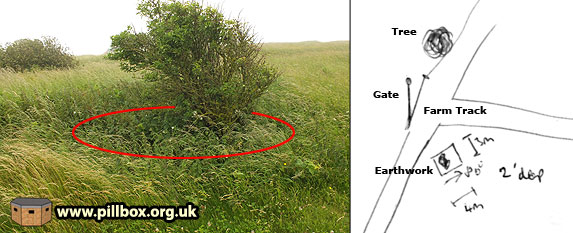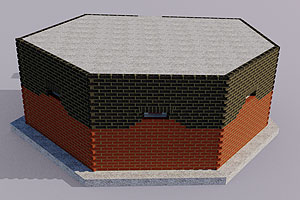Bomb craters (3) - Eastbourne
Posted: 5 July 2012 22:35
In Part 2 we looked at the landscape evidence of some bomb craters near Lewes and I promised that we'd look at another two craters; further research for this post has, however, revealed a third!

I found these craters completely by accident, again whilst hunting for slit trenches back in 2009; their location can be broadly described as being in the Eastbourne area.
A bomb report I recently discovered in the National Archives described in minute detail a series of bombs that fell along the path on the Downs in the photo at right.
A wander along this path revealed no conclusive evidence of any of the six 50kg bombs that made an impact on the surface; we'll come back to this raid later.
The craters I had previously found were about 500 metres away, but there is no evidence as yet to suggest that they occurred as part of the same incident, although I'm not ruling it out.
The graphic below shows how busy the area is in terms of earthworks.
Starting on the right, we have the two Vickers gun positions that I reported on in 2009. It was at this time that I stumbled upon all three craters, but I didn't even bother to record two of them in my notes, such was my failure to recognise them for what they were. The 1944 features are all related and form part of the anti-aircraft defences during the build-up to D-Day.

Following my numbering sequence from Lewes, I refer to the Eastbourne craters as 3,4 and 5. Let's take a look at these now; because they're situated on pasture land, long grass heavily obscures them and you can stand six feet away from one in the summer months and not know it's there!
This makes photographing them almost impossible even when the grass is short, hence the contours I've added to crater no.3 in the photo below.
Crater 3
This feature is, on average, 3.5m diameter and about 85cm deep, making it smaller than craters 1 and 2 at Lewes (both roughly 6m diameter) and crater 4 that we'll look at next.

Crater 4
Crater 4 is shown in the photo below; a bit deeper at 1.22m, it proved slightly easier to capture digitally, thanks to strong sunlight and shadow. The diameter is also greater than crater 3, at 5 metres.

Below is the section I measured across crater 4; it has the classic saucer shape to it.

Crater 5
Crater 5 was the only one of the three to be included in my original field notes - and this was only because I mistook it for another Vickers gun position!

Because the crater itself is so overgrown and has a tree growing in it, I somehow convinced myself it was a rectangular (4x3m) feature and about 60cm deep. The graphic at right includes a photo and a scan of my original field notes with digital annotation.
Even today, I have been unable to take a section across this feature - it's that overgrown! As I was not completely happy with my identification, I promptly forgot all about it until now.
Proof these are bomb craters
I only recognised crater 5 by chance after I was trying to identify an unrelated feature I had seen in Google Earth. I remembered that I had copied a series of aerial photographs of this area in The National Archives (TNA) and upon further investigation, suddenly realised that the photo included the area in which craters 3-5 lie.
In the photo, I saw three white 'splashes' of chalk - it looked as though three large flour bombs had been dropped on top of the Downs and in a straight line. I've read in a report about how bombs in a 1943 raid on the outskirts of Brighton showered nearby houses with chalk dust. Rain would eventually wash it away, but it perhaps indicates that when the photo was taken, these craters were quite fresh. (The photo is dated just six weeks after the raid in which six bombs fell 500 yards away).
I could immediately tie in craters 3 and 4 with two of these splashes, but it wasn't until I was back on the ground and looking for evidence of the third crater that I found myself staring at the overgrown hole I had tentatively identified as a Vickers position three years before and had forgotten all about.
The graphic below shows how all three craters are on a straight line.

Bomb evidence?

I was pleasantly surprised as I was attempting to locate crater 5 last week whilst gathering data for this blog post to chance upon a splinter of metal, as shown in the photo at right. It certainly has the look of something that has suffered some explosive trauma - metal this thick doesn't otherwise fragment this small with jagged edges.
I constantly find odd pieces of artillery shell splinters on the Downs - but only in areas that were designated as artillery ranges. The area in question does not appear to have been such an area, and three years of wandering this area has not yielded one single piece of metalwork until now.
The other key piece of evidence is the thickness of this casing - 20mm. This is far thicker than the artillery shell fragments I've picked up in the past 30+ years.
The thickness of a bomb casing can be used as an aid to identification, and the manual Objects dropped from the air includes a table of dimensions of bomb walls at key points in the casing.
The thickness of this splinter matches that of either the SD50 or SD250 bombs, and, having found it just 30m away from crater 5 and between it and crater 4, it is very tempting to make a connection here.
But do these sizes of bomb make craters in chalk of the size of these three examples?
We need to look again at the crater measurements and familiarize ourselves with some of the bomb types in greater detail - we'll do this in Part 4.
- Pete

Email:
Blog Latest

Bishopstone reveals its pillbox secrets
18 October 2021

Pillbox or Observation Post?
10 June 2020

Uncovering the hidden secrets of a pillbox
8 June 2019

Review of 2018
31 December 2018

Wartime Christmas in East Sussex (2)
24 December 2018
Jargon-buster
Slit trench
Small, narrow trench designed to provide protection against shrapnel and other battlefield hazards. Technically distinct from a weapon pit (which was intended soley as a defensive position) slit trenches were also used as defence works.
TNA
The National Archives (formerly The Public Records Office or PRO).
This site is copyright © Peter Hibbs 2006 - 2024. All rights reserved.
Hibbs, Peter Bomb craters (3) - Eastbourne (2024) Available at: http://pillbox.org.uk/blog/216703/ Accessed: 27 July 2024
The information on this website is intended solely to describe the ongoing research activity of The Defence of East Sussex Project; it is not comprehensive or properly presented. It is therefore NOT suitable as a basis for producing derivative works or surveys!